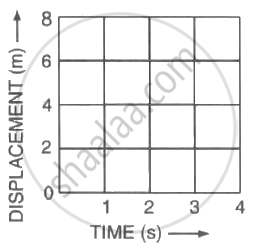Advertisements
Advertisements
Question
From the displacement – time graph shown given below calculate:
- Average velocity in the first three seconds.
- Displacement from the initial position at the end of 13 s.
- Time after which the body is at the initial position,
- Average velocity after 8 s.

Solution
(i) In first three seconds
Total displacement = 8m
Total time = 3 s
Average velocity = Total displacement/Total time = 8/3
= 2.67 ms−1
(ii) Displacement from the initial position at the end of 13s = −8m.
(iii) Body is at the initial position after 8s and 17s.
(iv) Average velocity after 8s is zero because, after 8s, displacement is zero.
APPEARS IN
RELATED QUESTIONS
If on a round trip you travel 6 km and then arrive back home :
What is your final displacement ?
A body travels a distance of 3 km towards East, then 4 km towards North and finally 9 km towards East.
What is the total distance travelled ?
Differentiate between distance and displacement.
Figure (a) shows the velocity-time graph for the motion of a body. Use it to find the displacement of the body at t = 1 s, 2 s, 3 s and 4 s, then draw on Figure (b), the displacement-time graph for it.
 |
 |
| (a) | (b) |
Under what condition is the displacement of a body equal to the distance traveled by it?
Distance travelled by a body in a given time ______.
A body moves is a circle of radius ‘2R’ what is the distance covered and displacement of the body after 2 complete rounds?
Write a note on the following:
Nautical mile
A quantity that has both magnitude and direction is ______.
Choose the correct option.
